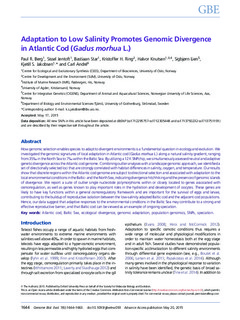| dc.contributor.author | Berg, Paul R | |
| dc.contributor.author | Jentoft, Sissel | |
| dc.contributor.author | Star, Bastiaan | |
| dc.contributor.author | Ring, Kristoffer H | |
| dc.contributor.author | Knutsen, Halvor | |
| dc.contributor.author | Lien, Sigbjørn | |
| dc.contributor.author | Jakobsen, Kjetill S | |
| dc.contributor.author | André, Carl | |
| dc.date.accessioned | 2015-09-29T12:36:38Z | |
| dc.date.available | 2015-09-29T12:36:38Z | |
| dc.date.issued | 2015 | |
| dc.identifier.citation | Berg, P. R., Jentoft, S., Star, B., Ring, K. H., Knutsen, H., Lien, S., . . . Andre, C. (2015). Adaptation to Low Salinity Promotes Genomic Divergence in Atlantic Cod (Gadus morhua L.). Genome Biology and Evolution, 7(6), 1644-1663. doi:10.1093/gbe/evv093 | nb_NO |
| dc.identifier.issn | 1759-6653 | |
| dc.identifier.uri | http://hdl.handle.net/11250/367754 | |
| dc.description | Published version of an article from the journal:Genome Biology and Evolution. Available from the publisher: http.//dx.doi.org/1093/gbe/evv093 | nb_NO |
| dc.description.abstract | How genomic selection enables species to adapt to divergent environments is a fundamental question in ecology and evolution. We investigated the genomic signatures of local adaptation in Atlantic cod (Gadus morhua L.) along a natural salinity gradient, ranging from 35% in the North Sea to 7% within the Baltic Sea. By utilizing a 12 K SNPchip, we simultaneously assessed neutral and adaptive genetic divergence across the Atlantic cod genome. Combining outlier analyses with a landscape genomic approach, we identified a set of directionally selected loci that are strongly correlated with habitat differences in salinity, oxygen, and temperature. Our results show that discrete regions within the Atlantic cod genome are subject to directional selection and associated with adaptation to the local environmental conditions in the Baltic- and the North Sea, indicating divergence hitchhiking and the presence of genomic islands of divergence. We report a suite of outlier single nucleotide polymorphisms within or closely located to genes associated with osmoregulation, as well as genes known to play important roles in the hydration and development of oocytes. These genes are likely to have key functions within a general osmoregulatory framework and are important for the survival of eggs and larvae, contributing to the buildup of reproductive isolation between the low-salinity adapted Baltic cod and the adjacent cod populations. Hence, our data suggest that adaptive responses to the environmental conditions in the Baltic Sea may contribute to a strong and effective reproductive barrier, and that Baltic cod can be viewed as an example of ongoing speciation. | nb_NO |
| dc.language.iso | eng | nb_NO |
| dc.publisher | Oxford University Press | nb_NO |
| dc.rights | Navngivelse 3.0 Norge | * |
| dc.rights.uri | http://creativecommons.org/licenses/by/3.0/no/ | * |
| dc.title | Adaptation to Low Salinity Promotes Genomic Divergence in Atlantic Cod (Gadus morhua L.) | nb_NO |
| dc.type | Journal article | nb_NO |
| dc.type | Peer reviewed | nb_NO |
| dc.subject.nsi | VDP::Agriculture and fishery disciplines: 900::Fisheries science: 920 | nb_NO |
| dc.source.pagenumber | 1644-1663 | nb_NO |
| dc.source.volume | 7 | nb_NO |
| dc.source.journal | Genome Biology and Evolution | nb_NO |
| dc.source.issue | 6 | nb_NO |
| dc.identifier.doi | 10.1093/gbe/evv093 | |

